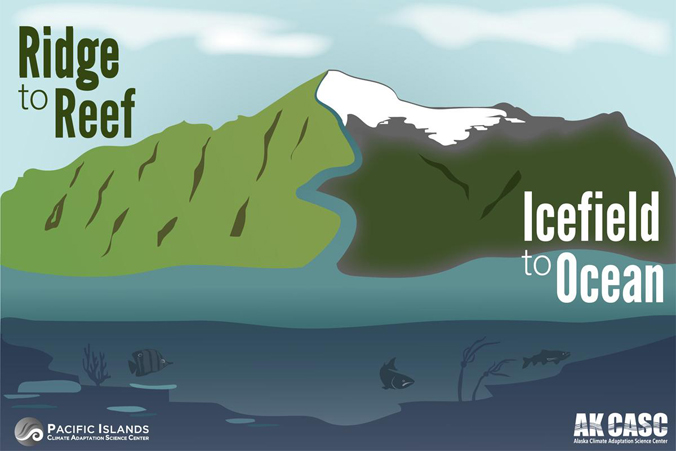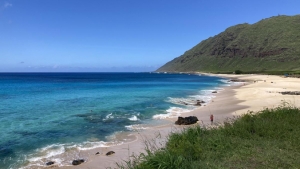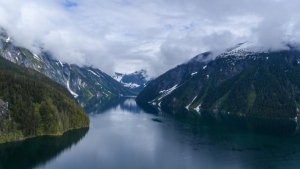
Thousands of miles from the tropical watersheds of the Pacific Islands, the temperate rainforests of Alaska’s southern panhandle face surprisingly similar challenges in a changing climate. Both regions feature steep watersheds with dramatic environmental gradients and confront significant alterations to watershed ecosystems and environmental processes due to climate change.
As these watershed ecosystems undergo climate-driven changes, two Climate Adaptation Science Centers, in Alaska (AK CASC) and the Pacific Islands (PI-CASC), have joined forces to address similar local challenges in a collaboration unique within the CASC network. PI-CASC is hosted at the University of Hawaiʻi at Mānoa, and includes consortium members UH Hilo and the University of Guam; AK CASC is hosted at the University of Alaska (UA) Fairbanks with consortium members UA Anchorage and UA Southeast.

The nine CASCs are regional partnerships between university consortia and the U.S. Geological Survey.
The Pacific Islands-Alaska (PI-AK) collaboration takes a holistic ecosystem view, acknowledging the natural links between land-based watersheds, coastal landscapes and the adjacent marine environments, by studying ecosystems from “ridge to reef” in the Pacific Islands and from “icefield to ocean” in Alaska. Funded projects of the collaboration aim to explore impacts to important cultural and ecosystem services provided by these linked land-to-coastal marine systems.
“The PI-AK collaboration has been great and continues to hold so much promise,” said the PI-CASC federal director, Mari-Vaughn Johnson. “This partnership highlights that, while the Pacific Islands and Alaska are thousands of miles apart, we are actually joined by the ocean, rather than separated by it. Projections suggest that Alaska and the Pacific Islands will both face dramatic changes to land-to-coast ecosystems, many of which will impact human relationships with natural and cultural resources.”
Traditional knowledge and science

In addition to the physical similarities shared by these coastal mountainous regions, Alaska and the Pacific Islands are connected by similar barriers to adaptation, such as sparse monitoring networks, challenging study environments, and inconsistent efforts to incorporate local cultural perspectives and knowledge into the research process. To address these limitations and better understand how these watersheds function and respond to climate and other stressors, there is an emphasis on collaborative research efforts that combine traditional knowledge and science to empower local adaptation decisions.
“PI-AK reinforces that our regions share many of the same needs and opportunities to develop scientist, manager and student capacity through co-production of actionable science. We both address critical resource management needs through university and federal research enterprises, incorporating local knowledge throughout the process,” said Bradley Romine, PI-CASC University Consortium deputy director and UH Mānoa extension specialist.
PI-AK funded projects were spotlighted in a special session at the 2022 Ocean Sciences Meeting. Research conducted jointly by the Alaska and Pacific Islands CASC scientists looks at the impact of changing streamflow patterns on salmon and coastal nutrients, future precipitation extremes, and how shifts in ecosystem processes such as flooding and streamflow will affect local species and communities, all described on a new PI-AK website.
“We hope this new website will serve as a living resource to document projects, relationships, and solutions-based science to support the Alaskan and Pacific Island communities,” Johnson said.
This collaboration is an example of UH Mānoa’s goal of Excellence in Research: Advancing the Research and Creative Work Enterprise (PDF) and Building a Sustainable and Resilient Campus Environment: Within the Global Sustainability and Climate Resilience Movement (PDF), two of four goals identified in the 2015–25 Strategic Plan (PDF), updated in December 2020.
Learn about projects and check for opportunities to participate in the collaboration at the PI-AK website.
–By Rachel Lentz

